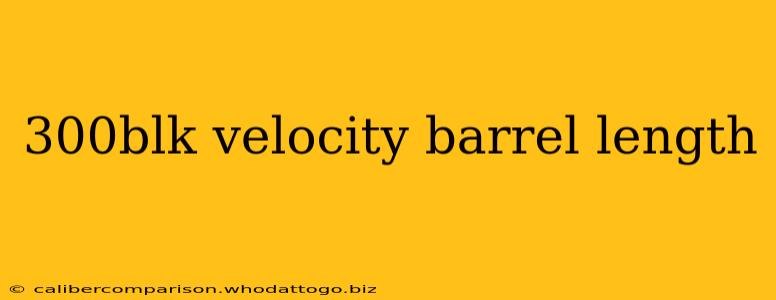The 300 Blackout (300 BLK) cartridge has rapidly gained popularity among shooters, largely due to its versatility and effectiveness in various applications, from close-quarters combat to hunting. A critical factor influencing the 300 BLK's performance is barrel length. Understanding the relationship between barrel length and velocity is crucial for optimizing your firearm's potential. This guide delves into the intricacies of 300 BLK velocity and how barrel length significantly impacts it.
The Impact of Barrel Length on 300 BLK Velocity
The 300 BLK cartridge, unlike some higher-pressure rounds, isn't significantly limited by shorter barrels. This characteristic contributes to its versatility in various firearm platforms. However, barrel length directly correlates with muzzle velocity. Generally:
-
Shorter barrels (under 8 inches): Produce lower velocities but offer advantages in maneuverability and concealability. They're ideal for close-quarters scenarios where the reduced recoil and shorter overall weapon length are advantageous. Subsonic ammunition thrives in shorter barrels, as the pressure drop helps maintain subsonic speeds.
-
Medium barrels (8-16 inches): Provide a balance between velocity and handling. They offer a noticeable improvement in muzzle velocity compared to shorter barrels while remaining relatively manageable. These lengths are a popular choice for many applications, offering a good compromise between velocity and practicality.
-
Longer barrels (over 16 inches): Maximize velocity, particularly with supersonic ammunition. The extra barrel length allows the propellant to burn more completely, translating into higher muzzle energy and longer range. However, they increase the overall firearm length and weight, reducing maneuverability.
Understanding the Ballistics: Supersonic vs. Subsonic
The 300 BLK's adaptability shines in its ability to handle both supersonic and subsonic ammunition.
-
Supersonic ammunition: Designed to exceed the speed of sound, supersonic 300 BLK rounds benefit significantly from longer barrels. The extended barrel length provides more time for the propellant to propel the bullet, resulting in higher velocities and flatter trajectories.
-
Subsonic ammunition: These rounds are designed to travel slower than the speed of sound. Shorter barrels can be beneficial for subsonic 300 BLK loads, helping to maintain subsonic speeds, minimizing the sonic boom, and reducing the chance of supersonic crack.
Practical Considerations and Applications
Choosing the optimal barrel length depends heavily on the intended application:
-
Home defense: Shorter barrels (7-8 inches) often prove ideal for maneuverability within confined spaces. The reduced recoil is also beneficial in stressful situations.
-
Hunting: Longer barrels (16 inches or more) are typically preferred to maximize velocity and effective range for hunting applications.
-
Concealed carry: Shorter barrels are essential for ease of concealment, prioritizing maneuverability over maximum velocity.
-
Competition: This largely depends on the specific discipline. Some competitions may favor shorter barrels for quick target acquisition, while others benefit from longer barrels for improved accuracy at longer ranges.
Conclusion
The relationship between barrel length and velocity in the 300 BLK cartridge is multifaceted. While longer barrels generally yield higher velocities, particularly with supersonic ammunition, shorter barrels offer significant advantages in maneuverability and suitability for subsonic loads. Ultimately, the optimal barrel length depends on the intended use and individual shooter preferences. Careful consideration of these factors ensures you select the best firearm for your needs.

